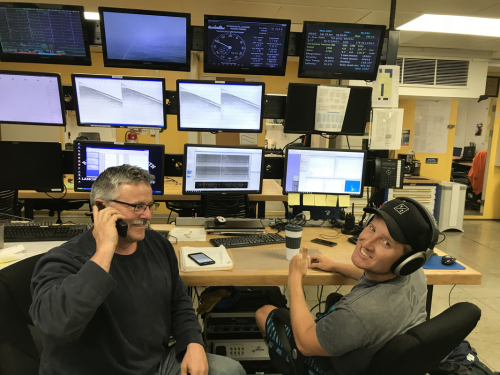
NZ3D Blog #5: Looking out for marine life

We commonly get asked about marine life when conducting these sort of scientific studies. The environment is very important to us, and the ship takes this job very seriously. Onboard we have a team of PSOs. This stands for Protected Species Observers who constantly look out for any marine mammals, turtles, and birds.
The PSOs can be found either in the lab or on the observation tower. The observation tower is the tallest point on the ship and is equipped with 2 giant pairs of binoculars. There are 2 PSOs on shift from 30 minutes before sunrise to 30 minutes after sunset, constantly looking out for any species. There is a 500m exclusion zone from all acoustic equipment, within which, if a marine mammal or pinoped is spotted, action is taken. If a mammal comes into the exclusion zone, the pressure of the acoustic waves we are producing is lowered to about 1/10th it’s normal pressure and the exclusion zone is decreased to 100m. If the mammal then enters the new exclusion zone, everything gets shut down. The mammal is monitored, and starting up doesn’t resume again until it has left the exclusion zone. A detailed report is taken of all species seen as well as any changes in behaviour within the exclusion zone and after shutdown. When we turn on the instruments we also do it by ‘ramping up’ which means slowly increasing the pressure, so any mammals can leave the area as the pressure gradually reaches maximum.
PSOs in the lab are using Passive Acoustic Monitoring systems, or PAM, 24 hours a day. This is sort of like a microphone which is towed behind the boat listening out for any mammals. These are usually clicks and whistles which can be used to track the mammals, calculate their bearing, and determine the range. PAM works really well but it’s difficult to identify a specific dolphin species from the clicks and whistles as they sound similar. Other mammals, such as Sperm whales, for example, have a much more distinctive sound.
There are 3 exceptions to shutdowns, and the only one we will see in this region is the common dolphin. A lot of research has been done about this species and it has been found that these curious guys have been known to swim right up to the ship and bow ride for a while, seemingly quite curious about the acoustic instruments. While shutting down is not necessary, a detailed report of the sightings and behaviour is still taken. We have been lucky enough to see a few playfully jumping through the waves along the bow! We have also seen many birds, including an albatross or two.
There are 5 PSOs onboard: Amanda, Sara, Brooke, Becky and Mark. While these guys work really hard, they are always happy to let us science crew come up to the observation tower for a look, and let us know if there are any sighting so we can go out and see for ourselves. They are all super knowledgeable about the marine life in the area and have loads of really interesting facts. The whole science party has had a turn wearing the PAM headphones listening to the clicks and whistles of nearby dolphins and it’s really amazing! It’s been a great cruise so far and fortunately no mammals, besides the common dolphin, have come near the exclusion zone, so data collection is going really well!
For more information about the voyage you can read: Hikurangi Seismic Surveying Fact Sheet
Disclaimers and Copyright
While every endeavour has been taken by the East Coast Lab Hikurangi Subduction Zone M9 to ensure that the information on this website is
accurate and up to date, East Coast Lab Hikurangi Subduction Zone M9 shall not be liable for any loss suffered through the use, directly or indirectly, of information on this website. Information contained has been assembled in good faith.
Some of the information available in this site is from the New Zealand Public domain and supplied by relevant
government agencies. East Coast Lab Hikurangi Subduction Zone M9 cannot accept any liability for its accuracy or content.
Portions of the information and material on this site, including data, pages, documents, online
graphics and images are protected by copyright, unless specifically notified to the contrary. Externally sourced
information or material is copyright to the respective provider.
© East Coast Lab Hikurangi Subduction Zone M9 - www.eastcoastlab.org.nz / +64 6 835 9200 / info@eastcoastlab.org.nz
